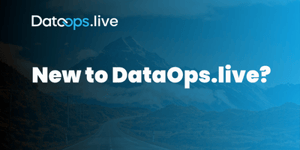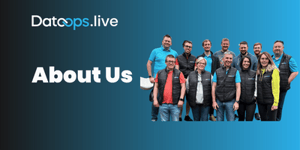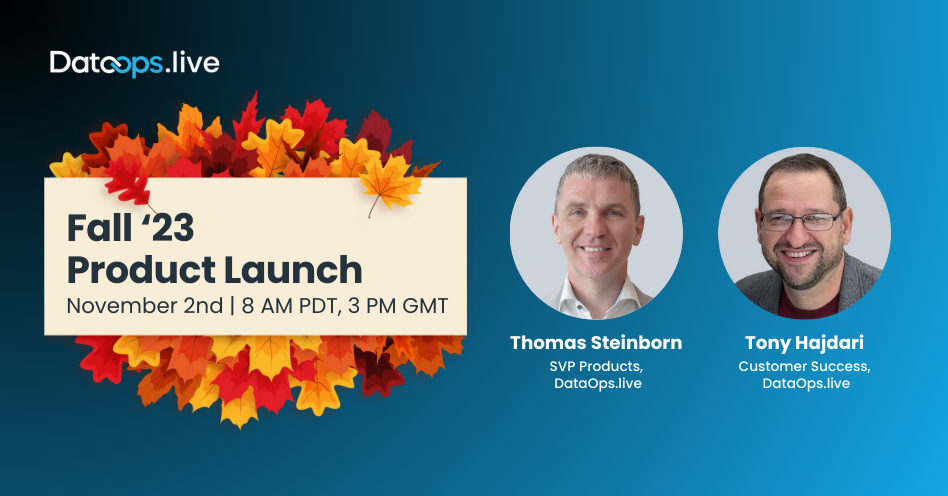Highlights of the Fall ’23 release of DataOps.live
How can you make an industry-leading data product management platform even better? By adding an AI-augmented experience that helps data engineers, data product owners, and developers work even faster.
Introduced in the Fall 2023 platform release, the AI-powered DataOps.live Assist helps data engineers become even more productive in data product management, creating SQL and Python models. It helps data product owners benefit from augmented code reviews and easier merge requests. And that’s just the beginning.
With an elegant user interface, it simplifies orchestration and enables teams to develop faster, in parallel, with full data product lifecycle management, unified observability, and complete data assurance.
“AI is in everybody’s minds these days, and we wanted to apply the technology creatively and appropriately in a #TrueDataOps context,” explains Thomas Steinborn, VP Products, DataOps.live, adding that “A core design principle with DataOps.live Assist is that your Snowflake data is always protected. No Snowflake data is sent to the AI—the DataOps.live platform only sends the prompt and tokenized SQL/Python—not raw code.”
“Bringing generative AI into the DataOps mix is designed to make peoples’ lives easier and more productive. DataOps.live Assist gives individuals, teams, and their organizations a head start.”
Increased productivity, improved observability, easier collaboration
So how can DataOps.live Assist help? “It increases your productivity by suggesting appropriate data transformations when creating a new model, for example” Thomas continues. “It helps you to generate models from natural language inputs. And it makes it easier to share everything you do across the organization, starting with your own team.”
It also accelerates documenting a project, with DataOps.live Assist recommending what documentation should be included. Thomas adds, “Since everything is backed by Git, you always have the ability to review and choose which changes and updates you want to commit to. Assist also helps you to onboard new team members fast, helping them to become more confident and efficient more quickly.”
A summary of a model is provided in one or more paragraphs, helping colleagues to pick up existing models and get to work rapidly on new development activities. “This is particularly useful for complex and lengthy SQL, when understanding 1000+ lines of SQL with many CTEs can be a painful prospect.” In addition, DataOps.live Assist summarizes merge requests, with a more detailed description of all changes. This further accelerates activity, enabling easier review, approval and collaboration.
And when pipelines fail, DataOps.live Assist provides you with blameless root cause analysis, helping data engineers and developers identify the why behind pipeline failures far more quickly than previously. This capability includes the provision of guided actions for ephemeral network failures.
What else is in the Fall ’23 release?
In addition to making AI accessible through DataOps.live Assist, additions to the DataOps.live development environment are now available to all customers in public preview.
- Snowflake Infrastructure as Code
- Data modeling and transformation
- Snowpark and Streamlit development
- Data product development
- First-time user set-up: Get started
- Using your Snowflake login from the IDE
Thomas Steinborn adds, “We’ve also updated the visual look and feel of the environment, including improved contrast. This means you can navigate more easily—for example, to go from the navigation bar to the Observe section, and specifically Spendview for Snowflake, with updates there including improved user management. These and other additions are all about making life easier and more productive—putting you in control.
“Last but not least, and closely related to the development environment, you can now use the Web IDE to launch an environment that is extremely similar to the DataOps development environment—however, the only thing you can do is edit your files, using a far more comfortable interface. It’s ideal for ad hoc users who might want to change a single file, as well as making life easier for people whose daily tasks involve 100% development"
For more details watch the Fall ’23 Launch Webinar






